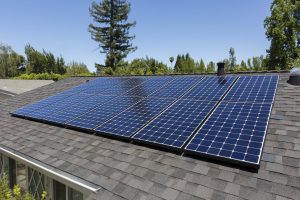Protecting Solar Panel Electronics with Parylene
Posted by Sean Horn
Friday, April 28, 2017 7:36
@ 7:36 AM
Like any other renewable energy technology, electronics for solar (photovoltaic) panels are necessary for transforming, transmitting, and monitoring the system. Unfortunately, system electronics can be fragile, and frequently are the panel’s weakest link. Converting the sun’s light to electricity, solar panels have demonstrated their utility in numerous operational contexts. The basic operational unit of panels, the solar cells themselves, can be used to power small scale products like calculators, re-chargeable batteries or watches; full panels can be adapted to a range of larger level operations, like powering homes, lighting systems or water treatment plants.
Despite their efficient utility as generators of clean energy, photovoltaic solar panels subjected to direct and persistent exposure to the sun, heat and other elements will suffer degradation over time. Suitable material structures are needed to:
- protect solar panels from this level of exposure,
- increasing their operational reliability and performance life.
Parylene Conformal Protection for Solar Panel Electronics
 Of existing conformal coatings, parylene provides optimal protection and performance assurance for solar panels. Its chemical vapor deposition (CVD) application process enacts molecule-by-molecule penetration of substrate surfaces; tiny coating particles adhere to every surface, penetrating every crevice and corner of the substrate; the result is a truly conformal coating of the solar assembly. Protection of panel electronics surpasses the brush/dip/spray methodologies of liquid coatings such as acrylic, epoxy, silicone and urethane. Parylene offers the best overall panel security and performance benefits of all the conformal coating types.
Of existing conformal coatings, parylene provides optimal protection and performance assurance for solar panels. Its chemical vapor deposition (CVD) application process enacts molecule-by-molecule penetration of substrate surfaces; tiny coating particles adhere to every surface, penetrating every crevice and corner of the substrate; the result is a truly conformal coating of the solar assembly. Protection of panel electronics surpasses the brush/dip/spray methodologies of liquid coatings such as acrylic, epoxy, silicone and urethane. Parylene offers the best overall panel security and performance benefits of all the conformal coating types.
Additional functional advantages of parylene conformal films include:
- chemically inert, solvent resistant panel substrate defense,
- consistent performance reliability,
- dry lubricant film properties,
- excellent resistance to incursions of moisture, salt sprays/mist,
- plasticity sufficient for use with flexible and semi-rigid circuits with a low incidence of surface cracking,
- high tensile strength,
- negligible, stress-free surface tension to provide superior protection for densely populated substrates and the most intricately designed solar circuits, whether flex-designed or rigid,
- optical transparency,
- particle immobilization,
- pinhole-free coating uniformity,
- thermal stability,
- ultra-thin, light weight with low outgassing, and
- very high dielectric properties.
These properties are very well aligned with conformal requirements for solar panel electronics, which include a need for:
- Flexibility: The capacity to be sufficiently supple to accommodate positional changes in the cell’s substrate, maintaining function without the formation of cracks to the film and subsequent delamination.
- Hermetical dependability: Completely sealing the panel’s electronic assemblies, protecting it from chlorofluorocarbons, H2O, O2 and similar agents of product degradation found in the external environment,
- Minimal gas permeability: The conformal barrier should obstruct potential penetration by gases such as oxygen and moisture.
- Stability: Parylene offers the necessary anti-corrosive, chemical, dimensional, electrical, and thermal stability to maintain solar panels’ functionality.
- Processing flexibility: Coating compatibility with solar assembly supports economic and energy minimization during the panel’s operation.
Currently solar panel/module systems carry a warranty of 25-30 years. Quality solar panels use top-of-the-line electronic assemblies, components and boards; precision electronics ensure panels dependably deliver energy, but can be subject to harsh use and hostile environments. Unfortunately, most panel electronics need replacement in 10-15 years, a condition that is:
- less than half the panel’s overall operational life, and
- a leading cause of downtime and repair expense.
For instance, parylene’s superior barrier properties provide oceanic/seaside solar farm installations with reliable protection. Outgassing is virtually non-existent; salt water and harsh winds have little effect on the panel’s performance. In comparison, liquid conformal coatings are damaged by these conditions, resulting in often severely degraded transmission signals, and diminished panel/farm performance. Equally, altitude has minimal adverse impact on parylene protective films.
Conclusion
Major applications of solar devices involve use of parylene conformal coatings. For solar panels, provision of extended operational lifetime and better quality panel performance is critical to their expanded adoption for energy production. Parylene’s functional properties enhance the feasibility of using solar devices, by conformally safeguarding panel electronics through a considerable range of operational conditions. Parylene films limit the impact of degradation and related failure mechanisms on solar panel performance, generating longer operational life and more efficient production of clean solar energy.
To learn more about parylene coating, download our whitepaper now:
Download our guide on Parylene 101
Comments
Homepage 4/17/2020. 10:17:10 AM
... [Trackback] [...] Informations on that Topic: blog.paryleneconformalcoating.com/whats-the-difference-between-potting-and-conformal-coating/ [...]

londondrugscanada.bigcartel.comlondon-drugs 4/17/2020. 10:17:10 AM
cialis uk https://londondrugscanada.bigcartel.com/london-drugs This is nicely expressed. !